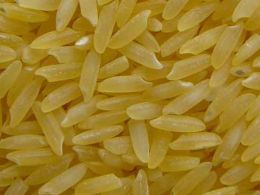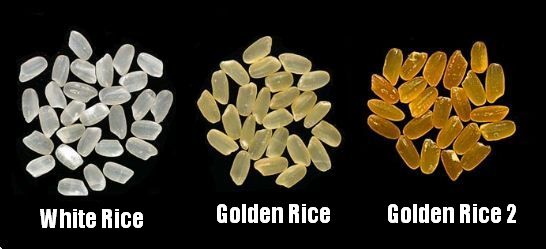What is Golden Rice?

Image of Golden rice
Golden rice is a form of rice with biosynthesis of beta-carotene (a form of vitamin A). In other words, golden rice is produced through genetic engineering. Beta-carotene gives golden rice its “golden” or “yellow” coloring. White rice, on the other hand, does not contain carotenoids (i.e. beta carotene) and therefore lacks that “golden” coloring. When you consume golden rice, the beta-carotene either accumulates in your fatty tissues or is transformed into vitamin A.
Carotenoids, like beta-carotene, are the colorful plant pigments normally found in a variety of fruits and vegetables (carrots, tomatoes, broccoli, cantaloupe, sweet potatoes, etc.). It is important to note that plants lack the direct form of vitamin A, but do contain beta-carotene, a form of vitamin A. Moreover, your body metabolizes vitamin A when you consume foods rich in beta-carotene. Vibrant fruits and vegetables, along with meats contain vitamin A. If you adhere to a poor diet, you have an increased risk of life-threatening medical conditions and diseases associated with a vitamin A deficiency.
Golden rice is rich in beta-carotene. It is also easily processed by your digestive system. In fact, the natural fatty lipids in golden rice aid in the absorption of beta-carotene, even when little or no oil is added to it. When oil is added to rice it helps your body absorb the carotenoids in it, but in the case of golden rice oil is not necessary to reap the benefits. Other benefits of golden rice include: increased energy (which comes from the starch located within the rice) and a low fat content.
Golden Rice History
Golden rice was invented in 1999 by Peter Beyer, professor at the University of Freiburg, Germany in the Centre for Applied Biosciences and Ingo Potrykus, professor at the Swiss Federal Institute of Technology at the Institute for Plant Sciences. Golden rice was originally produced in 1982 as an initiative for the Rockefeller Foundation. In 1992, a group of research experts and scientists met to perform studies on golden rice pros and cons. Beyer and Potrykus developed a rather complex biosynthetic crop that could be altered to produce healthier and more abundant grains like rice.

Peter Beyer and Ingo Potrykus
Golden Rice and Vitamin A
It is important to understand that golden rice is considered a type of genetically modified rice (GMO). It is a fortified food that is produced to combat a vitamin A deficiency in areas where this vitamin is scarce. More and more people are being diagnosed with a vitamin A deficiency. In fact, young children are the most vulnerable to vitamin-related deficiencies. Approximately 1 million children die of a vitamin A deficiency each year.
A vitamin A deficiency can severely affect a child’s eyesight; weaken his/her immune system function and increase his/her risk of chronic conditions. Moreover, in underdeveloped countries, approximately half-a-million people, mostly children, develop blindness, associated with a vitamin A deficiency. Approximately 50% of those diagnosed with this type of deficiency-related blindness die a year or two after becoming blind (Wright, Hinchliffe & Adams, 2005). To make matters worse, approximately 10 million children suffer from malnutrition every year. In severe cases, the malnutrition turns deadly (Wright, Hinchliffe & Adams, 2005).
Low levels of vitamin A can also negatively affect your immune system and cause serious illnesses and/or death. In the last few years, an increase in child deaths (under the age of five) has been linked to deficiencies in vitamin A, protein and zinc. The newest form of golden rice varies from the original strain through the addition of three new beta-carotene genes.
In addition, this newest form of golden rice (invented in 2005) is referred to as Golden Rice 2 because it contains higher levels of beta-carotene then the original golden rice. Golden rice was originally developed, with the support of environmental activists, to improve, enrich, support and enhance health and well-being and it has accomplished its goals. The invention of golden rice has lowered the risk of a variety of health conditions and ailments. Golden rice has been tested in the Philippines for over two seasons on two different locations in 2012.

White rice vs Golden Rice
Golden Rice Benefits
– Lowers Risk of Blindness, Infections, Cancers and Diseases
Golden rice has the ability to lower your risk of blindness, infections, cancers and diseases. A vitamin A deficiency can increase your risk of vision impairments, age-related macular degeneration and blindness. It can also worsen infections (measles, HIV, AIDS, chicken pox, etc.), especially in children. Approximately 125 million children, worldwide, exhibit chronically low levels of vitamin A (Wright, Hinchliffe & Adams, 2005). The carotenoids found in golden rice can combat adult degenerative diseases. Other benefits of golden rice include: a lower risk of both a variety of heart diseases and prostate, breast and skin cancers.
– Reduces Gastrointestinal Distress
Another one of the benefits of golden rice is that it can reduce gastrointestinal distress. In fact, it is considered a beneficial food to eat following an episode of diarrhea, regardless of the cause. Golden rice behaves like a mild astringent in your gastrointestinal system, which supports easy digestion and restores your intestinal mucus following an episode of gastroenteritis and colitis.
– Reduces High Blood Pressure and High Cholesterol
Golden rice is a low-fat and low-sodium food; therefore it is especially beneficial for lowering high blood pressure and cholesterol. High levels of sodium, a mineral, can lead to fluid accumulation, edema (fluid retention) and a spike in blood volume. The excess fluid can increase your risk of high blood pressure. In other words, the more sodium you consume, the higher your blood pressure may soar. Moreover, one of the most valuable benefits of golden rice is that it prevents fiber-related biliary acids from accumulating in your intestines. Biliary acids found in the liver and transported to your intestines, aid cholesterol production. Golden rice contains no fat (i.e. no cholesterol); therefore it has the ability to regulate your unhealthy blood cholesterol levels.
Problems with Golden Rice
Controversy has surrounded the production of golden rice because it is considered genetically modified rice (GMO). Critics have raised concerns of using genetically engineered foods to combat vitamin deficiencies like vitamin A. One of the main problems with the original form of golden rice was that it did not contain enough vitamin A to be beneficially for reducing disease risks. This problem was rectified when the new form of golden rice, Golden Rice 2 was developed in 2005. Critics continue to not only question the effectiveness of using genetically modified rice to improve health, but also the degree to which the nutrients persist once the rice has been cooked.
In a recent study (2009), it was found that golden rice was just as beneficial and effective as supplementing with vitamin A (Tang, Qin, Dolnikowski, Russell & Grusak, 2009). An organization called Greenpeace, vehemently opposes the production and use of golden rice citing this GMO will encourage the development of more GMOs in the future. Anti-GMO activists argue that an increase in GMOs will cause the degradation of foods to the point where everything that we eat will be artificial and genetically engineered. In the long run these types of non-natural foods will cause a variety of health problems (Tang, Qin, Dolnikowski, Russell & Grusak, 2009).
These activists also argue that a balanced diet that contains beta-carotene (kale, mustard, greens, carrots, broccoli, sweet potatoes, etc.) provides an adequate amount of vitamin A and should therefore be utilized first and foremost. Supporters of GMOs argue that although it would be nice if everyone could adhere to a balanced diet rich in vitamin A, it just is not possible for some people. These supporters cite a lack of available resources and poverty as two of the main reasons why some people have developed nutritional deficiencies. They state that it is important to have alternative food sources to eliminate vitamin deficiencies and improve health and well-being. More research is needed to get a full understanding of golden rice pros and cons.
References:
Schaub, P., Al-Babili, S, Drake, R & Beyer, P. (2005). Why is golden rice golden (yellow) instead of red? Plant Physiology 138 (1). 441–450.
Tang, G., Qin, J., Dolnikowski, G. G., Russell, R. M. & Grusak, M. A. (2009). Golden rice is an effective source of vitamin A. American Journal of Clinical Nutrition 89(6). 1776–83.
Wright, S. Y., Hinchliffe, E. & Adams, J. L (2005). Improving the nutritional value of golden rice through increased pro-vitamin A content. Nature Biotechnology 23(4). 482–7.

 Facebook
Facebook  Twitter
Twitter  RSS
RSS







